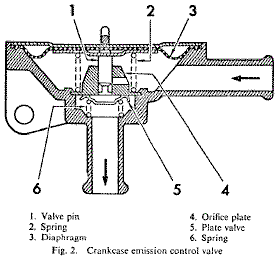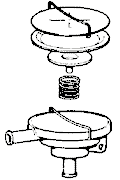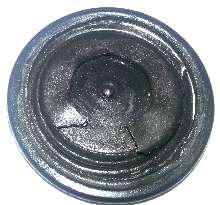The MGA With An Attitude
Functional description for the Positive Crankcase Ventilation valve, late 60's to early 70's vintage from BMC (not original equipment on the MGA):
When the engine starts vacuum in the intake manifold begins to draw air through the valve body. Since there is some restriction at the valve cover inlet, a small vacuum develops in the crankcase. As soon as there is vacuum present in the valve body it uses atmospheric air pressure to push the diaphragm down to close the poppet valve. As the poppet approaches the valve seat it restricts air flow. The internal cavity of the valve body is then isolated from manifold vacuum and is exposed to the lighter vacuum level in the crankcase. If the poppet was to closed all the way it would stop air flow completely, resulting in no vacuum in the valve body, and the spring would push the valve open. So it settles into a state of equilibrium with a very small air flow and a light vacuum in the valve body. The pressure differential between atmospheric pressure and the lower crankcase absolute pressure pushes the diaphragm with just enough force to compress the spring. The light vacuum in the valve body and the crankcase is a result of air flow and the inlet restriction at the valve cover. The magnitude of that low vacuum level is determined by the strength of the spring working against the diaphragm. A stronger spring would hold the valve open a bit more making more air flow and higher crankcase vacuum. Result of all this is, with engine idling there is a small air flow going through the crankcase. The carburetor will be adjusted to enrich fuel mixture slightly to accommodate this extra air input and result in correct overall air fuel ratio. When you hit the throttle to accelerate manifold vacuum drops. This would result in slightly less air flow through the PCV valve. Less flow decreases vacuum in the crankcase. Since the crankcase vacuum is controlling the diaphragm, the valve opens a bit more to admit more air flow. Increased flow increases crankcase vacuum due to the inlet restrictor, and the valve closes a little. End result of this balancing act is, with lower manifold vacuum the valve is open slightly more, but the crankcase vacuum and air flow remain about the same as when it was idling. Since the diaphragm is controlled by crankcase vacuum, the crankcase vacuum level and ventilation air flow remain fairly constant over a wide range of operating conditions and manifold vacuum. The flow volume of ventilation air going through the crankcase is determined by the vacuum level and the size of the inlet restrictor orifice. Blow-by gasses from the pistons into the crankcase would want to increase crankcase absolute pressure (still below atmospheric pressure). Increasing crankcase pressure allows the diaphragm to lift opening the valve poppet a bit. This allows more air to flow from crankcase to inlet manifold, and the PCV valve will be passing both the ventilation air and the blow-by gasses. When valve flow has increased enough to match the blow-by volume, the crankcase vacuum will then draw the valve diaphragm down to regulate the original vacuum level in the crankcase, resulting also in the same original ventilation flow through the inlet restrictor. Hitting the throttle harder you get lower manifold vacuum and more blow-by making higher crankcase pressure. Both of these things conspire to open the PCV valve more to allow more flow until the original crankcase vacuum level is restored. End result of all this is that the PCV valve will open as much as is required to allow flow of blow-by gasses in any variable amount while retaining the same vacuum level in the crankcase. When you close the throttle at high engine speed you get very high vacuum in the intake manifold and virtually zero blow-by. This causes higher vacuum at the PCV valve, so the diaphragm pulls down to close the valve some to reduce flow. The reduced flow brings down the vacuum at the crankcase side of the valve until it gets back to equilibrium again with the same original crankcase vacuum and ventilation rate. So the PCV valve is doing two things. It is maintaining a constant light vacuum level in the crankcase, and it is modulating air flow to exactly match the crankcase ventilation volume and blow-by volume combined at all times. The proper description for this device is then "vacuum modulated flow control valve". Or if you think in terms of crankcase absolute pressure you can call it "pressure modulated flow control valve". For the common folk we just call it the PCV valve. There are a few unnatural operating conditions for this valve. First, if you remove the oil filler cap when running you lose the crankcase vacuum. With increased absolute pressure in the crankcase the PCV valve will open wider in attempt to process this perceived excess "blow-by". When the valve cannot increase flow enough to restore crankcase vacuum, the best it can do is to go wide open. When allowing maximum flow of air through the PCV valve the engine idle will speed up a little, and the fuel mixture will go lean, and it should have a slightly rough fast idle. Second, putting your hand over the oil filler port and closing off the valve cover inlet vent will stop all ventilation air flow through the crankcase. This will cause higher vacuum in the crankcase that will make the PCV valve go completely closed, except it may stay open just a crack to process blow-by gasses. Stopping the fresh air ventilation flow will make the engine idle slightly slower, and the fuel mixture will be a little rich, so it should then have an abnormally slow rough idle. Third, if the valve cover inlet vent should happen to get clogged up during normal operation, the results will be similar to the second case with rich running. This can foul spark plugs and carbon up combustion chambers as well as accumulating water and other nasty things in the crankcase. Resulting damage could lead to a large repair bill. This could happen if the inlet filter in a vented oil filler cap becomes clogged. That is why service instructions call for changing the vented type oil cap periodically. Fourth, if the piston rings or cylinder walls are badly worn, beyond the normal expected range of normal engine life (or if the piston rings are stuck in the grooves), the blow-by volume may be more than the PCV valve can process. In this case the PCV valve will be wide open and there may also be positive pressure in the crankcase. This would result in reverse flow through the valve cover inlet vent and possible expulsion of oil past the normal engine seals. Then you can hang up your jock and go home while you contemplate the cost of the required engine overhaul. Thank you for attending, and you can pick up your diploma on the way out. Addendum August 212, 2022: You can view the original patent here: https://worldwide.espacenet.com/patent/search/family/010453499/publication/GB1095759A?q=pn%3DGB1095759A. |


